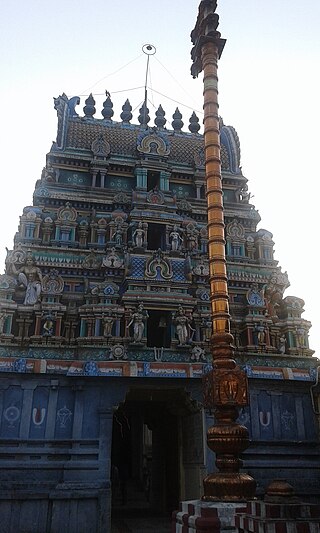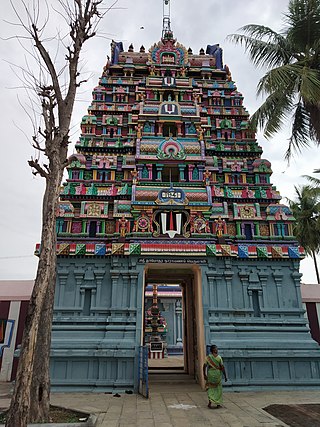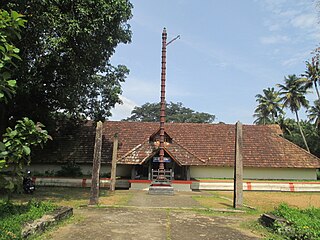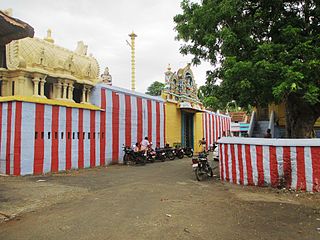
The Malayalam Calendar, or the Kollam Era, is a sidereal solar calendar used in Kerala. The origin of the calendar has been dated to 825 CE, commemorating the establishment of Kollam.

The Adikesava Perumal Temple is a Perumal temple located in Thiruvattar, Kanyakumari district, Tamil Nadu, India and is one of the 108 Divya desams, the holy sites of Hindu Vaishnavism in existing Tamil hymns from the seventh and eighth centuries C.E. The temple is one of the historic thirteen Divya Desams of Malai Nadu. The temple is a picturesque setting surrounded on three sides by rivers namely, It was the Rajya Temple and Bharadevatha shrine of Erstwhile Travancore. After state reorganisation, the temple was handed over to Tamil Nadu H&RCE Dept. Since Vishnu resides here in a reclining position, and is surrounded by rivers, the temple is called as "The Srirangam of Chera Kingdom".

Rama Kulasekhara was the last ruler of the Chera Perumal dynasty of medieval Kerala. He was a contemporary to Chola kings Kulottunga I (1070–1120) and Vikrama Chola. Rama Kulaskehara is best known for briefly recovering Kollam-Trivandrum-Nagercoil region from the powerful Chola empire around 1100/02 AD.
Kulasekhara, one of the twelve Vaishnavite alvars, was a bhakti theologian and devotional poet from medieval south India. He was the author of "Perumal Tirumoli" in Tamil and "Mukundamala" in Sanskrit. The Perumal Tirumoli, whose second decade is known as "Tetrarum Tiral", is compiled as a part of Nalayira Divya Prabandham. The Trikkulasekharapuram Temple in Kodungallur is associated with Kulasekhara Alvar.

The Mukundamala is a Sanskrit hymn composed by the Hindu poet-saint Kulasekhara, seventh of the twelve Alvars of the Sri Vaishnava tradition. Comprising 40 verses, the hymn is addressed to the deity Krishna.

Thondaradippodi Alwar or Vipra Narayana was one of the twelve Alwar saints of South India, who are known for their affiliation to Vaishnava tradition of Hinduism. The verses of Alwars are compiled as Naalayira Divya Prabandham and the 108 temples revered are classified as Divya desam. Thondaripodi is considered the tenth in the line of the twelve Alwars.

The Devaadi Raja Perumal temple in Therazhundur, a village in Mayiladuthurai district of the South Indian state of Tamil Nadu, is dedicated to the Hindu god Vishnu. Constructed in the Dravidian style of architecture, the temple is glorified in the Naalayira Divya Prabandham, the early medieval Tamil canon of the Alvar saints from the 6th–9th centuries CE. It is one of the 108 Divya Desams dedicated to Vishnu, who is worshipped as Amaruviappan, and his consort Lakshmi as Sengamalavalli Thayar. The original structure of the temple was built by the Karikala Chola during the 1st century CE, with later additions from the Cholas during the 11th century.
Tiruppan Alvar was one of the twelve Alvars of South India, who were poet-saints known for their affiliation to the Sri Vaishnava tradition of Hinduism. The verses of the Alvars are compiled as the Naalayira Divya Prabandham and the 108 temples revered in the text are classified as Divya Desams. Tiruppan Alvar is considered the eleventh in the line of the twelve Alvars.

The Arulmigu Prasanna Venkatesa Perumal Temple is a temple dedicated to Venkateshvara, a form of the Hindu deity Vishnu. It is located at the Indian village of Thirupparkadal at Ranipet district, Tamil Nadu. It is considered one among the 108 Abhimana Kshethram of Vaishnavate tradition.
Kulasekhara is a South Asian male name, used as both given and last name, prevalent in south India and Sri Lanka.

Thirumoozhikulam Sree Lakshmanaperumal Temple is located in Thirumoozhikalam (Moozhikkulam) in Ernakulam district of Kerala, India. The temple finds mention in some of verses of ancient Tamil Vedam sung by the Sri Vaishnava Alvars, particularly Nammalvar and Tirumangai Alvar and classified as Divya Desams, the 108 holy temples revered in the canon. This belongs to one of the 13 Malai Naatu (Kerala/Chera) Divya Desams, the Divya Desams located in Kerala.

The Loganatha Perumal Temple is a Hindu temple dedicated to Vishnu located 2 km away from Sikkal, Tamil Nadu, India on the Tiruvarur-Nagapatnam highway. Constructed in the Dravidian style of architecture, the temple is glorified in the Nalayira Divya Prabandham, the early medieval Tamil canon of the Alvar saints from the 6th–9th centuries CE. It is one of the 108 Divya Desams dedicated to Vishnu, who is worshiped as Loganatha Perumal and his consort Lakshmi as Loganayagi.

The Neelamegha Perumal Temple or Sowriraja Perumal Temple is a Hindu temple in Thirukannapuram, a village in the outskirts of Nagapattinam in the South Indian state of Tamil Nadu, is dedicated to the Hindu god Vishnu. Constructed in the Dravidian style of architecture, the temple is glorified in the Divya Prabandha, the early medieval Tamil canon of the Alvar saints from the 6th–9th centuries CE. It is one of the 108 Divya Desam dedicated to Vishnu, who is worshipped as Neelamegha Perumal and his consort Lakshmi as Thirukannapura Nayagi. As per Hindu legend, the presiding deity is believed to have appeared with a wig to save a devotee, leading to the name Sowriraja Perumal.

Ulagalantha Perumal Temple or Trivikrama Temple is a Hindu temple dedicated to Vishnu located in Tirukkoyilur, Tamil Nadu, India. Constructed in the Dravidian style of architecture, the temple is glorified in the Naalayira Divya Prabandham, the early medieval Tamil canon of the Alvar saints from the 6th–9th centuries CE. It is one of the 108 Divya Desams dedicated to Vishnu, who is worshipped as Ulagalantha Perumal and his consort Lakshmi as Poongothai. The temple is believed to have been built by the Medieval Cholas, with later contributions from Vijayanagara kings and Madurai Nayaks. The temple covers an area of 5 acres (20,000 m2) and has a temple tower that is the third tallest in Tamil Nadu, measuring 192 ft (59 m) in height.

Vaithamanidhi Permual Temple is one of the nine Nava Tirupathi, the Hindu temples dedicated to Vishnu. It is located on the village of Thirukkolur which is located on Thoothukudi district of Tamil Nadu, India. The village is 4 km away from Alwarthirunagari. It is the eighth temple of Nava Tirupathi, and is named after Mars (Sevvai) and also called Kuberasthalam. Constructed in the Dravidian style of architecture, the temple is glorified in the Nalayira Divya Prabandham, the early medieval Tamil canon of the Alvar saints from the 6th–9th centuries CE. It is one of the 108 Divya Desams dedicated to Vishnu, who is worshipped as Vaithamanidhi Perumal and his consort Lakshmi as Kolurvalli.

The Thrichittatt Mahavishnu Temple is a Hindu temple dedicated to Vishnu, located in Chengannur, Alappuzha District, Kerala, South India. Constructed in the Kerala style of architecture, the temple is glorified in the Nalayira Divya Prabandham, by Nammalvar, one of the Sri Vaishnava saint-poets of the 8th century called the Alvars. It is one of the 108 Divya Desams dedicated to Krishna, an avatar of Vishnu, who is worshipped as Imayavarappan. The nearest railway station to the temple is located in Chengannur, while the nearest airports are Trivandrum International Airport and Cochin International Airport Ernakulam.

The Thripuliyoor Mahavishnu Temple is a Hindu temple dedicated to Vishnu and located in Puliyoor, Alappuzha District, Kerala, South India. Constructed in the Kerala style of architecture, the temple is glorified in the Nalayira Divya Prabandham, the early medieval Tamil canon of the Alvar saints from the 6th–9th centuries CE. It is one of the 108 Divya Desams dedicated to Vishnu, who is worshipped as Mayapiran/Thripuliyoorappan. The nearest railway station to the temple is located at Chengannur, while the nearest airport is Trivandrum International airport.

Thirumittakode Anchumoorthi Temple is a Hindu temple equally associated with the deities Vishnu and Shiva. Temple is situated on the banks of the Bharathappuzha at Thirumittacode of Palakkad District in Kerala state in India. The five statues - one for Shiva and four Vishnu - are known here as Thirumattikodu five (Anchu) Moorthy Temple.
Keezhperoor or Kupaka is a village located 6 kilometers from Kilimanoor in Thiruvananthapuram district of Kerala. It houses Thirupalkadal Sreekrishnaswamy Temple, family temple of Venad, Kizhakkumkara Devi Temple, and Thekkumkara Mahadeva Temple.

The Thiruvazhmarban Temple, also known as Sri Kuralappa Perumal Temple in Thiruppathisaram, a village in Kanyakumari district in the South Indian state of Tamil Nadu, is dedicated to the Hindu god Vishnu. Thiruvazhmarban Temple is located about 5 km far, north-easterly to Nagercoil, 20 km far, north-westerly to Kanyakumari and 45 km south-west of Nanguneri Divya Desam. Constructed in the Dravidian style of architecture, the temple is glorified in the Nalayira Divya Prabandham, the early medieval Tamil canon of the Alvar saints from the 6th–9th centuries CE. It is one of the 108 Divya Desams of malayala nadu divyadesham dedicated to Vishnu, who is worshipped as Thiruvazhmarban and his consort Lakshmi as Kamalavalli in kerala tantric traditions. The oldest inscription in the temple is from 1139 CE indicating gifts to the temple. A granite wall surrounds the temple, enclosing all its shrines. The temple tank is located opposite to the temple, outside the main entrance.

















